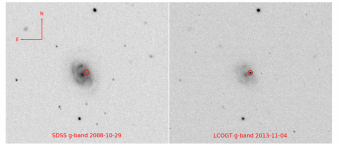There are arguably a lot of things defy categorization, but it’s not everyday that we find something that suggests we do away with our categories altogether. The authors of today’s paper believe that the recently-discovered Type II supernova ASASSN-13co — read that as “assassin”, please — might just be one of the latter. Its unusual characteristics call into question the validity of the two classes (II-P and II-L, more on that later) into which we usually group Type II supernovae. As a result, they suggest that we treat Type II supernovae properties as a continuum, rather than the discrete designations we’ve become accustomed to assigning.
Death Throes of Massive Stars
 Type II supernovae are identified by the hydrogen in their spectra (meaning that they still have a hydrogen envelope when they die). They are formed when a star with mass of 8-50 times that of the sun dies through core-collapse.
Type II supernovae are identified by the hydrogen in their spectra (meaning that they still have a hydrogen envelope when they die). They are formed when a star with mass of 8-50 times that of the sun dies through core-collapse.
All stars produce energy through nuclear fusion, but massive stars can fuse much heavier nuclei than stars the size of our sun – all the way to nickel and iron, which have the highest binding energy of all elements. While the fusion of the lighter elements is an exothermic process, fusing iron uses up energy instead, so fusing elements heavier than iron isn’t energetically favorable. As a result, a core of iron and nickel (which then decays into iron) builds up in the center of a massive star. The core is supported by electron degeneracy pressure. When the mass of the iron-nickel core exceeds the Chandrasekhar limit (about 1.4 solar masses), however, electron degeneracy pressure is not enough to stop the core from collapsing. As the core collapses, the protons and electrons in the core of the star merge to form neutrons and neutrinos. The neutrinos can escape and carry away energy. At the same time, the outer layers of the star fall inward until neutrondegeneracy pressure kicks in, stopping the collapse and causing the outer layers to rebound. The combination of the pressure from the neutrinos and the rebound of the outer layers off of the core causes the star to be torn apart in a huge explosion – a core-collapse supernovae.
Read the article on Astrobites

